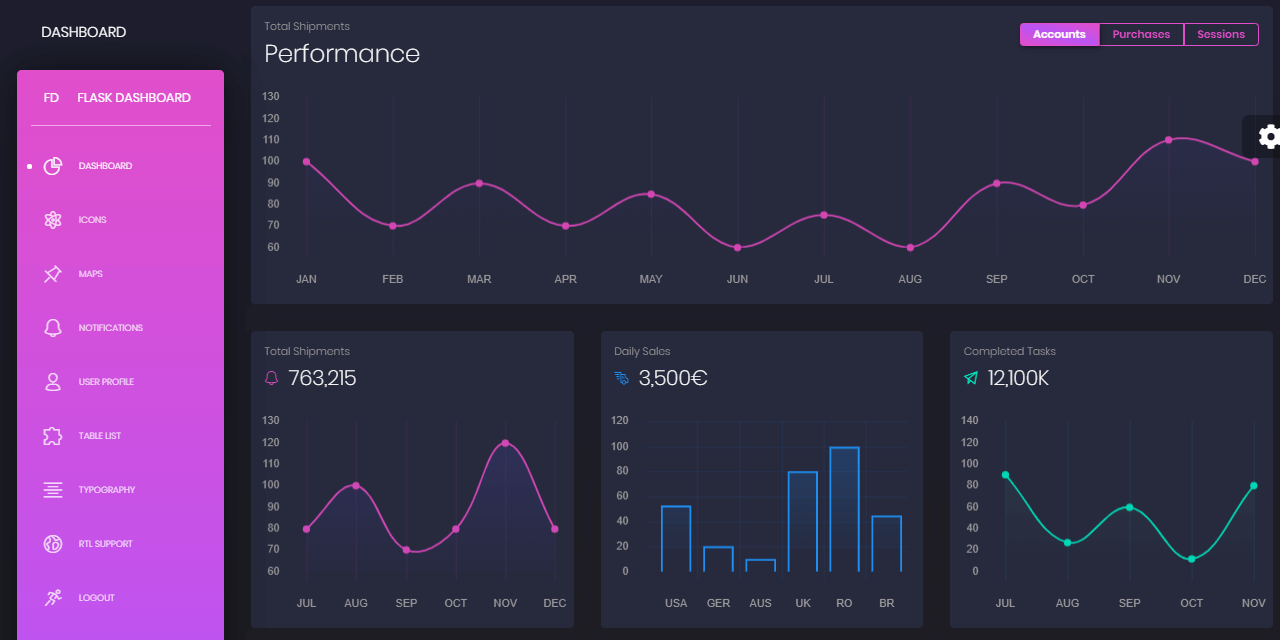Flask Command-Line is an open-source sample project that extends the classic Flask CLI with new commands. The code includes a few commands from a simple hello to something more useful like listing the application configuration. For newcomers, FLASK CLI gives access to the application context, database and helpers.
Features
- Define a new Blueprint
commands - Define Custom Command
hellothat echos a simpleHello World- Usage:
flask commands hello
- Usage:
- Define Custom Command
cfgthat prints all configuration variables and optionally filter the output.- Usage:
flask commands cfg- print all variables used by the app - Usage:
flask commands cfg SQL- filtered output
- Usage:
- Support via Github (issues tracker) and Discord.
Implementation Summary
- Create the commands Blueprint
- Update the
app factoryto include and register the Blueprint - Code
Hello Worldcommand - Code
Cfgcommand
Links
- Flask Dashboard Black - Free Starter with more features:
- Authentication, Blueprints, Dual Config (dev & production), Deploy scripts.
- Flask Dashboard Black - Demo - LIVE App deployment
$ # Get the code
$ git clone https://github.com/app-generator/flask-command-line.git
$ cd flask-command-line
$
$ # Virtualenv modules installation (Unix based systems)
$ virtualenv env
$ source env/bin/activate
$
$ # Virtualenv modules installation (Windows based systems)
$ # virtualenv env
$ # .\env\Scripts\activate
$
$ # Install modules - SQLite Database
$ pip3 install -r requirements.txt
$
$ # List available commands
$ flask commands # commands = the name of the Blueprint
$
$ # Call Hello Command
$ flask commands hello # this will print a dummy message
$
$ # Call CFG Command
$ flask commands cfg # list all variables
$ flask commands cfg sql # filter the output that matches `SQL`
$
$ # Set the FLASK_APP environment variable
$ (Unix/Mac) export FLASK_APP=run.py
$ (Windows) set FLASK_APP=run.py
$ (Powershell) $env:FLASK_APP = ".\run.py"
$
$ # Start the application (development mode)
$ # --host=0.0.0.0 - expose the app on all network interfaces (default 127.0.0.1)
$ # --port=5000 - specify the app port (default 5000)
$ flask run --host=0.0.0.0 --port=5000
$
$ # Access the dashboard in browser: http://127.0.0.1:5000/Note: To use the app, please access the registration page and create a new user. After authentication, the app will unlock the private pages.
Command
hello- to customize the message, open the commands file and updatehello()
$ flask commands hello
Custom command - Hello # <-- the output Command
cfg- Unfiltered output
$ flask commands cfg
Custom command - Cfg(None)
|- ENV -> production
|- DEBUG -> False
|- TESTING -> False
|- PROPAGATE_EXCEPTIONS -> None
|- PRESERVE_CONTEXT_ON_EXCEPTION -> None
|- SECRET_KEY -> S3cr3t_K#Key
|- PERMANENT_SESSION_LIFETIME -> 31 days, 0:00:00
|- USE_X_SENDFILE -> False
|- SERVER_NAME -> None
|- APPLICATION_ROOT -> /
|- SESSION_COOKIE_NAME -> session
|- SESSION_COOKIE_DOMAIN -> None
|- SESSION_COOKIE_PATH -> None
|- SESSION_COOKIE_HTTPONLY -> True
|- SESSION_COOKIE_SECURE -> False
|- SESSION_COOKIE_SAMESITE -> None
...
(truncated output)Command
cfg- Filtered output (case insensitive)
$ # Filter ouput that matches `database`
$ flask commands cfg database
Custom command - Cfg(Filter=database)
|- SQLALCHEMY_DATABASE_URI -> sqlite:///...\flask-command-line-blueprints\db.sqlite3
$
$ # Filter ouput that matches `JSON`
$ flask commands cfg JSON
Custom command - Cfg(Filter=JSON)
|- JSON_AS_ASCII -> True
|- JSON_SORT_KEYS -> True
|- JSONIFY_PRETTYPRINT_REGULAR -> False
|- JSONIFY_MIMETYPE -> application/jsonThe project is coded using blueprints, app factory pattern, dual configuration profile (development and production) and an intuitive structure presented bellow:
Simplified version
< PROJECT ROOT >
|
|-- app/ # Implements app logic
| |-- base/ # Base Blueprint - handles the authentication
| |-- home/ # Home Blueprint - serve UI Kit pages
| |
| commands.py # Defines the custom commands <-- NEW
| __init__.py # Initialize the app <-- UPDATED
|
|-- requirements.txt # Development modules - SQLite storage
|-- requirements-mysql.txt # Production modules - Mysql DMBS
|-- requirements-pqsql.txt # Production modules - PostgreSql DMBS
|
|-- .env # Inject Configuration via Environment
|-- config.py # Set up the app
|-- run.py # Start the app - WSGI gateway
|
|-- ************************************************************************The bootstrap flow
run.pyloads the.envfile- Initialize the app using the specified profile: Debug or Production
- If env.DEBUG is set to True the SQLite storage is used
- If env.DEBUG is set to False the specified DB driver is used (MySql, PostgreSQL)
- Call the app factory method
create_appdefined in app/init.py - Redirect the guest users to Login page
- Unlock the pages served by home blueprint for authenticated users
Flask Command Line - Open-source sample provided by AppSeed App Generator.
